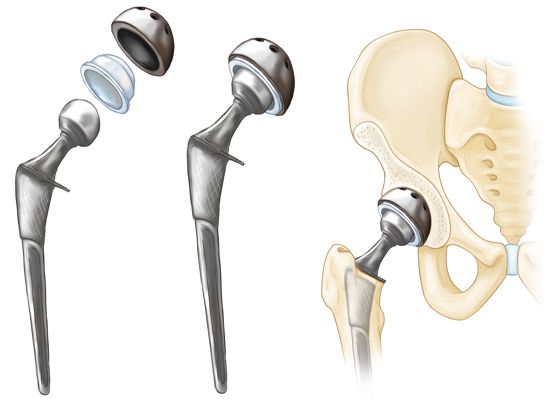Hip Replacement Surgery
What is hip replacement surgery?
Hip replacement surgery (total hip arthroplasty) replaces a worn-out or injured hip joint. The surgeon replaces the old joint with an artificial joint (prosthesis). This surgery may be an option following a hip fracture or for significant discomfort caused by arthritis.

Conditions to be treated by hip replacement surgery are:
Osteoarthritis:
This is a degenerative joint condition that primarily affects middle-aged and elderly people. It has been linked to the disintegration of hip joint cartilage and nearby bone.
Rheumatoid Arthritis:
The synovial lining of the joint is inflamed in this kind of arthritis. It results in an increase in synovial fluid. It can cause severe pain and stiffness.
Traumatic Arthritis:
Arthritis is caused by trauma. An injury has resulted in this arthritis. It may potentially cause hip cartilage injury.
What are the types of hip replacement surgery?
- Total hip replacement (most common)
- Partial hip replacement
- Hip resurfacing
Total hip replacement is the most common type of hip replacement surgery (also called total hip arthroplasty). During this procedure, worn-out or damaged hip parts are replaced with artificial implants. The socket is replaced with a strong plastic cup that may or may not have a titanium metal casing. Your femoral head will be removed and replaced with a ceramic or metal alloy ball. The new ball is linked to a metal stem that is placed on your femur’s top.
Partial hip replacement (also known as hemiarthroplasty) entails replacing only one side of the hip joint — the femoral head — rather than both sides as in total hip replacement. This operation is most typically performed on elderly individuals who have suffered a hip fracture.
Hip resurfacing of the femoral head and socket is most often performed on younger, more active patients.
What happens during a hip replacement procedure?
- Hip replacement surgery frequently requires a hospital stay. Procedures may differ depending on your situation and the procedures of your healthcare practitioner.
- Hip replacement surgery is performed while you are sedated or sleeping under a general anaesthetic.
In general, hip replacement surgery proceeds as follows:
- You will be asked to remove your clothes and given a gown to wear.
- In your arm or hand, an IV (intravenous) line may be started.
- You’ll be placed on the operating table.
- After you have fallen asleep, a urinary catheter may be implanted.
- During the procedure, your doctor will monitor your blood pressure, heart rate, and blood oxygen level.
- An antiseptic solution will be used to clean the skin above the surgical site.
- A hip incision will be made by the healthcare professional.
- The damaged portions of the hip joint will be removed and replaced with the prosthesis by the medical professional. The hip prosthesis is composed of a stem that is placed into the thigh bone (femur), a head joint (ball) that fits into the stem, and a cup that is inserted into the hip joint’s socket. Metal is used for the stem and cup. Metal or ceramic balls can be used. The cup has a lining, which might be plastic or ceramic. Cemented prostheses and uncemented prostheses are the two most prevalent types of artificial hip prosthesis used. Surgical cement is used to secure a cemented prosthesis to the bone. An uncemented prosthesis has a porous surface that adheres to the bone. To attach to the prosthetic, bone grows on this surface. A combination of the two types is sometimes used to replace a hip.
- Stitches or surgical staples will be used to close the incision.
- To remove the fluid, a drain may be put at the incision site.
- A sterile bandage or dressing will be applied to the wound.
What are the types of hip replacement surgery?
In Hospital
Following surgery, it is critical to begin moving the new joint. Soon after your surgery, a physical therapist will meet with you to create an activity rehabilitation programme for you. Your pain will be managed with medication, allowing you to participate in the workout. You will be given an exercise regimen to follow both while in the hospital and after you are discharged.
You will be sent home or to a rehabilitation facility. In either scenario, your healthcare provider will make arrangements for you to continue receiving physical therapy until you rebuild muscular strength and range of motion.
At Home
Once you’ve returned home, it’s critical to keep the surgery area clean and dry. Bathing instructions will be provided by your healthcare practitioner. During a subsequent appointment visit, the stitches or surgical staples will be removed.
As directed by your healthcare professional, take pain medication for soreness. Aspirin and other pain relievers may raise the risk of bleeding. Take only the medications that have been prescribed for you.
Recovery time after hip replacement surgery
Within 24 hours, you will begin physical therapy with a physical therapist. Your therapist will assist you with sitting up, getting in and out of bed, and practicing walking and climbing stairs using a walker, cane, or crutches.
After that, you will have physical therapy outside of the hospital for 6 to 8 weeks. After that time, most patients are able to resume normal activities.
If you experience any joint pain, Book your appointment with an orthopedics specialist at KK speciality clinic and hospital.
